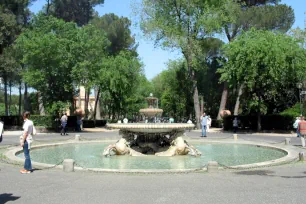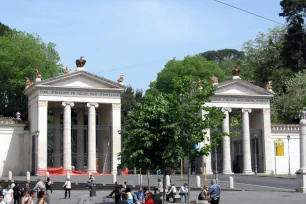Villa Borghese is the largest public park in Rome. It offers a pleasant refuge from the often hectic streets in the city. The park features a lake, temples, fountains, statues and several museums.



The park is located just north of the Spanish Steps. The main entrances are at the Piazzale Flaminio (near Piazza del Popolo) and the Porta Pinciana at the end of the Via Veneto.
History
The area started as a vineyard in the sixteenth century. In 1605, cardinal Scipione Borghese, a nephew of pope Paul V, turned the vineyard into a park.
Landscaper Domenico Savino da Montepulciano designed a very formal park with geometric shapes, the first such park in Rome. A villa was built by the architect Flaminio Ponzio after a sketch from the cardinal himself.
The park was later laid out in a more natural way. At the end of the eighteenth century, an artificial lake was created in the middle of the park. On the island in the lake, a small Ionic temple was built. It is dedicated to Aesculapius, the god of healing.
A Public Park
In 1903, the city of Rome obtained Villa Borghese from the Borghese family and opened the park to the public. The eighty hectare/148 acre-large park now featured wide shady lanes, several temples, beautiful fountains and many statues.
1911 World Exposition
In 1911 the World Exposition was held in this park. Several of the pavilions built by some of the participating countries still exist. The most impressive of these is the British School, built after a design by Edwin Lutyens. Other buildings represented Austria, Denmark, Romania, Belgium, The Netherlands, Egypt and Sweden.
Park of Museums


Dubbed the ‘park of museums’, the Villa Borghese park is also home to several museums.
The most famous is the Museo e Galleria Borghese, housed in the Villa Borghese, the building after which the park is named. It has a collection of sculptures with some important works by Canova and Bernini, including the latter’s masterpiece ‘Abduction of Proserpina by Pluto’. The Galleria Borghese also houses a collection of paintings by several masters, including Titian, Rubens and Raphael.
The Galleria Nazionale d’Arte Moderna is located on the grounds of the 1911 World Exposition. The museum has a collection of nineteenth- and twentieth-century paintings. It contains mostly works from Italian artists.
Not far from the Galleria Nazionale d’Arte Moderna is the Museo Nazionale Etrusco. It displays a collection of pre-Roman objects, mostly Etruscan, excavated around Rome. The museum is housed in the Villa Giulia, a villa built in 1553 as the summer residence of pope Julius II.

More sights
The park also contains an amphitheater (the Piazza di Siena), an arch from the eighteenth century (the arco di Settimio Severo) and a botanical garden.
You might also notice Triton statues, which look exactly like those on the Fontana del Moro (Moor Fountain) in the Piazza Navona. The originals were moved from the piazza to the park; the Tritons on the Piazza Navona fountain are actually nineteenth-century replicas.
- Next: Palatine Hill
- More Sights & Attractions in Rome

